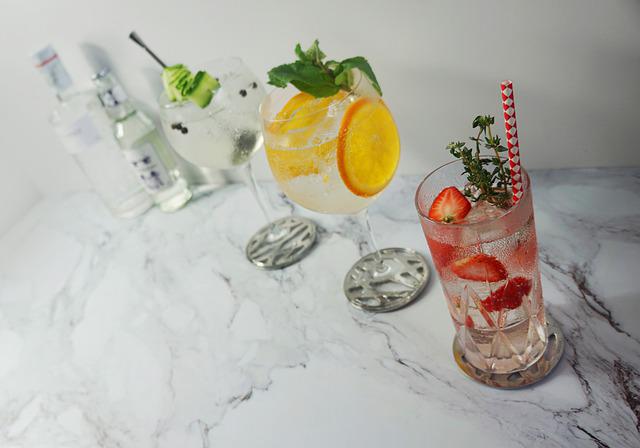Gin, gin, glorious gin….
It’s been a long hot summer, and a long cold G&T’s been one of my chill-out favourite tipples. There are so many exciting small distilleries of gin in Britain at the moment. A quick look at the shelf here currently reveals tasty gins from at least three of the four ‘home’ nations so far, with examples from St Andrews in Scotland; Brecon in Wales; Durham and Lindisfarne in England’s north east, and gins from London.
In Scotland, gins have been booming so much – using exciting additional, local botanicals like sea buckthorn, and even (whisper it low) outpacing whisky – that jokes have been coined about a Scottish ‘ginaissance’.
I like to drink my gins ‘long’, slow, and lasting, with a generous amount of an interesting tonic and plenty of ice. Usefully, gin has fewer calories than wine or sugary soft drinks, and carefully chosen mixers help to keep my recreational G&Ts that way.
Happily, gin’s also an ancient medicinal drink. I have sufficient faith in its restorative roots that it’s even infused at key moments into my magical realist novel ‘Felix Unbound’, where some of its old curative powers come in handy even when the 21st century character choosing it knows nothing of the mystic past of its defining ingredient: the little juniper berry.
Ancient Romans would burn juniper branches as purifiers; but as a drink made with the berries, the earliest records trace to 11th century CE monks at a Benedictine monastery in Salerno in southern Italy. Already distilling medicines using medicinal herbs, it seems they decided to give the plentiful local juniper berries a go too.
Juniper and the drinks derived from it went on to enjoy a long history of medicinal use before it became a leisure tipple. Across mediaeval Europe, juniper-infused wines provided tonics for sufferers of anything from plague to colds, and muscular aches and pains. In the 1600s, Dutch and Flemish distillers tried re-distilling malted spirits or wines with juniper as the main ‘botanical’, producing what became known as ‘Jenever’ or ‘Genever’ – soon known as ‘gin’ in Britain.
Gin’s reputation suffered a major downward dive as ‘mother’s ruin’ in early 18th century England – depicted gruesomely then by London artist William Hogarth – but today the little juniper berry is once again credited with superfood powers, and modern gins are said to yield a host of health benefits…when drunk in moderation, of course, Mr Hogarth…with niche distilleries springing up all over Britain.
Although I love gin as a summer drink, it has all-year round charms too. Mixed long, I find it a really good drink with ‘hot’ spicy foods, for instance.
Serendipitously, the Gunn clan’s official plant or flower is the juniper: a specific flower would be worn as a badge identifying your clan – on the battlefield, for example. For me that connection is fun to know, but really I just enjoy the drink (peacefully)!

